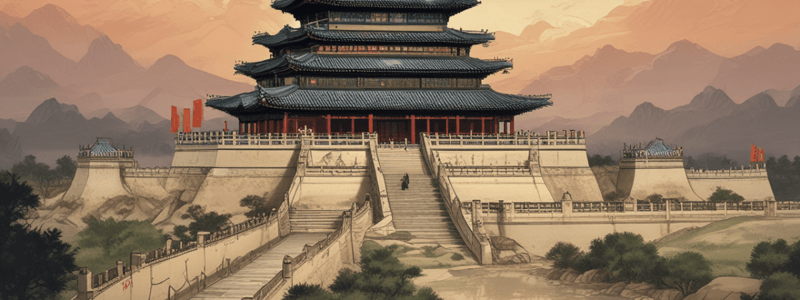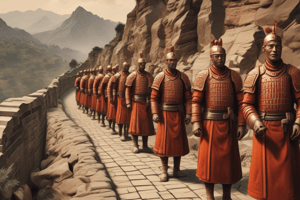Podcast
Questions and Answers
Which dynasty is credited as the first imperial dynasty of China?
Which dynasty is credited as the first imperial dynasty of China?
- Qin Dynasty (correct)
- Qing Dynasty
- Tang Dynasty
- Han Dynasty
Who was the self-proclaimed first emperor of China who established the Qin Dynasty?
Who was the self-proclaimed first emperor of China who established the Qin Dynasty?
- Confucius
- Emperor Wu
- Qin Shihuang (correct)
- Kublai Khan
What notable construction began during the Qin Dynasty that later became a symbol of China?
What notable construction began during the Qin Dynasty that later became a symbol of China?
- The Great Wall of China (correct)
- The Pyramids of Egypt
- The Colosseum in Rome
- The Taj Mahal in India
What major achievement in literature is associated with the Qin Dynasty?
What major achievement in literature is associated with the Qin Dynasty?
Which aspect was NOT an achievement of the Qin Dynasty?
Which aspect was NOT an achievement of the Qin Dynasty?
Who standardized the writing system across the whole country?
Who standardized the writing system across the whole country?
Which philosophy was followed by the Qin Dynasty?
Which philosophy was followed by the Qin Dynasty?
What was the focus of Legalism as a philosophy in the Qin Dynasty?
What was the focus of Legalism as a philosophy in the Qin Dynasty?
Who founded the Han Dynasty after the fall of the Qin Dynasty?
Who founded the Han Dynasty after the fall of the Qin Dynasty?
What is the European name for China thought to be derived from?
What is the European name for China thought to be derived from?
Flashcards are hidden until you start studying
Study Notes
Qin Dynasty
The Qin Dynasty, which lasted from 221 to 206 BCE, was the first imperial dynasty of China. It is remembered for its military strength and its role in unifying the country after the Warring States period.
Establishment of the First Imperial Dynasty of China
The Qin Dynasty was established by the self-proclaimed first emperor of China, Qin Shihuang (259-210 BCE). He accomplished a series of swift conquests, eventually gaining control over the whole of China and creating a unified nation.
Achievements and Impact
During its reign, the Qin Dynasty achieved increased trade, improved agriculture, and revolutionary developments in military tactics, transportation, and weaponry, such as the sword and crossbow. The dynasty is also known for several impressive feats in architecture, sculpture, and other art, including the beginnings of the Great Wall of China, the construction of the Terracotta Army, and the standardization of the writing system.
Architecture
Qin architecture is characterized by defensive structures and elements that conveyed authority and power, as exemplified by the early beginnings of the Great Wall.
Literature
Under the Qin Dynasty, a standardized system of Chinese writing was created, which unified Chinese culture for thousands of years. Prime Minister Li Si standardized the writing system across the whole country, and Li Si is credited with creating the “lesser-seal” style of calligraphy, also known as small seal script, which served as a basis for the modern Chinese writing system and is still used in cards, posters, and advertising today.
Warring States Period and Legalism
The Qin Dynasty arose from the state of Qin, which gave its name to China as it was the westernmost state. It operated according to the precepts of the philosophy of Legalism, which focused on the text of written law to the exclusion of the intent of law, elevating strict adherence to law over justice, mercy, grace, and common sense.
Decline and Succession
When Qin Shihuang died in 210 BCE, his son was placed on the throne by two of the previous emperor's advisers, who attempted to influence and control the administration of the entire dynasty through him. However, these advisers fought among themselves, which resulted in both their deaths and that of the second Qin emperor. Popular revolt broke out a few years later, and the weakened empire soon fell to a Chu lieutenant, who went on to found the Han Dynasty. Despite its rapid end, the Qin Dynasty influenced future Chinese empires, particularly the Han, and the European name for China is thought to be derived from it.
Studying That Suits You
Use AI to generate personalized quizzes and flashcards to suit your learning preferences.



